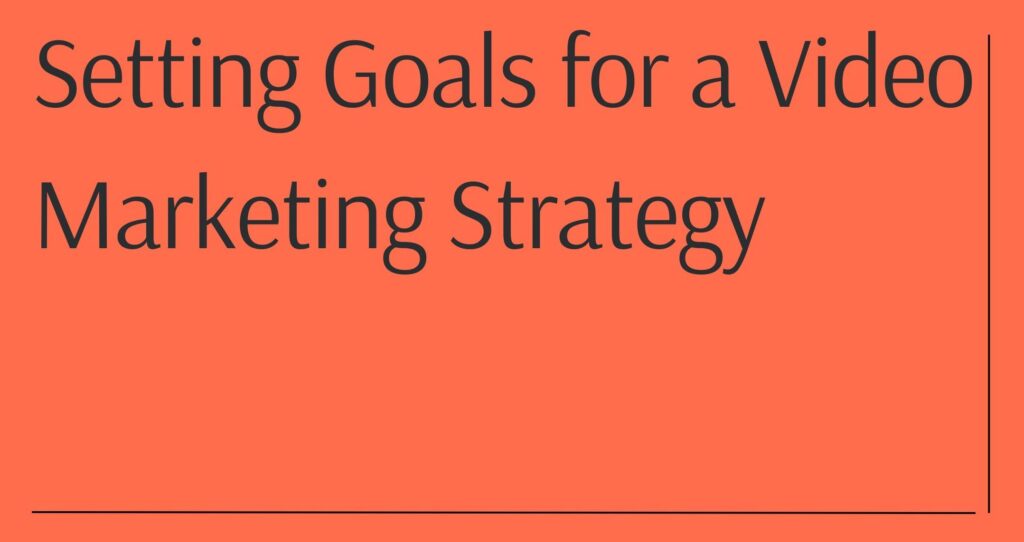Video has become the go-to tool for marketing. Everywhere you look, brands are pushing clips, short reels, polished ads, and behind-the-scenes glimpses. And honestly, it makes sense. Video grabs attention in a way static posts rarely can.
But here’s the reality: not every brand sees results. Many put time, money, and energy into producing videos that barely make a difference. They look good, maybe even get a few likes, but they don’t translate into growth.
The difference usually comes down to one thing, clear goals.
Without goals, video marketing is just noise. With goals, it becomes a system that pulls people toward your business step by step. That’s why goal-setting isn’t just helpful, it’s the foundation of a video marketing strategy that actually works.
Why is Goal Setting Important when Developing a Video Marketing Strategy?
Setting Goals Gives You Direction
One of the hardest parts of video marketing is figuring out where to start. Do you make an explainer video? A product demo? A funny reel to jump on a trend?
The truth is, none of those answers is wrong, but without a goal, they might not be right either. Goals act like a compass. They give direction so you’re not just experimenting blindly.
- If you’re trying to get noticed, you create short, attention-grabbing videos designed to spread fast.
- If you’re trying to earn trust, you make educational content that shows expertise.
- If you’re trying to drive sales, you focus on testimonials, demos, and offers.
- If you’re trying to retain customers, you produce tutorials, updates, or personalized content.
See the difference? Goals cut through the noise and help you decide exactly what to make. Without them, you’re essentially shooting in the dark.
When you don’t set goals, you risk trying to do all of these at once, which usually means doing none of them well. Goals force you to prioritize. They give your strategy focus so you’re not just creating content, you’re creating content that moves the needle.
Setting Goals Keeps You From Chasing the Wrong Thing
It’s tempting to measure success by surface-level numbers: views, likes, shares. Those are easy to track, and they feel rewarding. But the question is, do they actually matter to your business?
For a local café, 100,000 views might sound impressive. But if none of those viewers live nearby, what’s the point? For a consulting business, a small video that gets 500 targeted views but brings in five paying clients is far more valuable than a viral clip that goes nowhere.
That’s the power of goals; they keep you grounded in what matters. Instead of chasing vanity metrics, you focus on outcomes tied directly to growth.
Setting Goals Defines the Right Video Type for Your Marketing
Not all videos serve the same purpose. Think about it.
- A quick, funny reel is great for brand awareness.
- A detailed tutorial is great for building trust and authority.
- A product walk-through is perfect for sales conversion.
- A heartfelt thank-you message keeps existing customers engaged.
When you know your objective, the type of video practically chooses itself. Without that clarity, it’s easy to waste effort on content that looks good but doesn’t move people closer to becoming customers or staying loyal. So, when your goal is clear, your format, length, and message fall into place naturally. Without that clarity, you might waste time producing videos that look good but don’t actually serve your business.
Setting Goals Decides Where You Post the Video
The platform you choose matters almost as much as the video itself. But again, the right platform depends on your goals.
- If your goal is awareness, you might lean into platforms with massive reach like TikTok, Instagram Reels, or YouTube Shorts.
- If your goal is building credibility, long-form YouTube videos or LinkedIn uploads might work better.
- If your goal is sales conversion, you could host videos directly on your website, in emails of email marketing, or in retargeting ads.
- If your goal is customer retention, private groups, onboarding emails, or direct customer portals might be the best place.
Without goals, you risk posting the wrong type of video in the wrong place, and that usually means wasted energy.
Setting Goals Keeps Teams on the Same Page
A video project often involves multiple people: marketers, creators, product managers, maybe even outside agencies. Without clear goals, everyone runs in different directions. Marketing wants reach, sales wants conversions, design wants aesthetics. Chaos.
Goals align the business growth. They act as a shared roadmap. Everyone knows why this video is being made, what outcome it should deliver, and how success will be measured. That alignment saves time, reduces friction, and ensures resources aren’t wasted on endless revisions or “creative disagreements.”
- Marketing might push for broad reach.
- Sales might want videos that generate leads.
- Creatives might chase aesthetics over outcomes.
Without a shared goal, everyone pulls in different directions. With clear goals, the whole team works toward the same outcome. It keeps projects on track, saves time, and avoids those endless rounds of “this isn’t what I envisioned.”
Setting Goals Helps You Measure What Really Matters
If you don’t know what you’re aiming for, how do you know if you’ve succeeded?
Goals give you the benchmarks. They define what to measure and how to evaluate performance. Here’s another overlooked truth: success in video marketing doesn’t mean the same thing for everyone. A startup chasing visibility might celebrate hitting 100,000 views. A B2B SaaS company might care less about views and more about the 200 demo requests that came through.
Your goals define your metrics. They tell you what to measure and what actually matters. Otherwise, you’ll end up celebrating “vanity metrics” like likes or shares without knowing if they’re doing anything for the business.
It’s better to hit a smaller, meaningful target than to chase big but empty numbers. That’s only possible when you start with goals.
For example:
- If the goal is awareness, you measure impressions, reach, or brand mentions.
- If the goal is engagement, you measure watch time, comments, or shares.
- If the goal is lead generation, you track sign-ups or downloads.
- If the goal is sales, you monitor conversions directly tied to videos.
- If the goal is retention, you look at repeat usage or customer satisfaction.
Without those benchmarks, it’s easy to misjudge success, either overestimating a campaign because it “looked popular” or underestimating one because it didn’t go viral.
Setting Goals Saves Time and Marketing Budget
For sure, making a video takes effort. Even a simple clip involves planning, shooting, editing, and distribution. Bigger productions multiply the costs. Without goals, you might invest heavily in videos that don’t actually benefit your business. But that doesn’t mean there are no benefits at all; there is still a huge list of benefits of video marketing if implemented right.
With goals, you allocate resources smarter. Instead of trying to make a dozen random videos, you create fewer but sharper ones that serve a clear purpose. That doesn’t just save money, it also saves your team from burning out on content that doesn’t deliver. When you set goals, you use resources efficiently.
You’re not making five random videos and hoping one sticks. You’re making one or two targeted videos that are designed to hit a specific objective. That’s smarter, leaner, and in the long run, far more effective.
Setting Goals Makes Scaling Possible
One of the overlooked benefits of goal-setting is that it creates a foundation you can build on. When you run a video with a clear objective, you can measure its performance. Did it hit the goal? If yes, great, double down. If not, adjust.
This feedback loop makes your video marketing scalable. Instead of guessing what to do next, you have data guiding your next move. Over time, that compounds into growth.
Businesses that skip goal-setting often burn out. They pour effort into creating, but since they don’t know what’s working, they can’t scale effectively. Setting goals keeps you on track for the long haul.
Here’s why:
When you set a goal, create a video, and measure against that goal, you get feedback. Maybe it works. Maybe it doesn’t. Either way, you learn. That learning compounds over time.
For example:
- If a short awareness video reaches double the people you expected, you know to make more like it.
- If a testimonial video fails to boost sales, you adjust the messaging before producing another.
This process builds a repeatable system. Over time, your video strategy becomes more efficient, predictable, and scalable. Without goals, you’re stuck guessing, never quite sure what worked or why.
Setting Goals Connects Video to Business Growth
At the heart of it, businesses don’t invest in video just for the sake of content. They do it because they want growth. Goals bridge the gap between creative energy and business outcomes.
They make sure that when you put effort into video, you’re not just producing something that entertains, but something that aligns with where your business needs to go:
- Reaching more people.
- Turning attention into trust.
- Converting trust into sales.
- Keeping customers loyal.
That’s the real difference between businesses that thrive with video marketing and those that just fill their feeds with content.
A Simple Question to Ask Before You Create a Goal for Your Video Marketing
If you take nothing else from this, remember this: before making any video, ask yourself, What do we want this to achieve?
That one question shapes everything: the idea, the format, the platform, even how you’ll measure success. Without it, you risk spending effort on something that looks good but goes nowhere. With it, you’re building a video marketing strategy that ties directly into growth.
Final Thoughts
Video is powerful, but power without direction rarely delivers results. Setting goals is what gives video marketing its edge. It provides focus, prevents wasted effort, and ensures every piece of content serves a clear purpose.
In a crowded online space, businesses that set goals don’t just create more video. They create better video. And better video is what drives awareness, builds trust, wins sales, and keeps customers around.
So before you roll the camera, pause for a second. Define the goal. Because in video marketing, that single step often makes the difference between looking busy and actually growing.

The Chief Author and Editor at Intothecommerce. As a seasoned expert in digital marketing, I direct the site’s strategic content and ensure every piece meets the highest industry standards. My insights drive our coverage on SEO, paid media, and cutting-edge marketing technology.






3 thoughts on “Why Is Setting Goals for a Video Marketing Strategy Important?”
I am eagerly anticipating your next posts on unexplored topics in the marketing space, as I have recently come across such content online.
I enjoyed reading this article. Thanks for sharing your insights on setting realistic goals for marketing; all I could see was a formulated one, not an experience. None dares to do it, but you’re doing it; keep us posted.
Video marketing is one tough thing to get into because we need consistent and worthwhile content with us ready to go live. So I can understand now how important it is to have a proper plan while setting up our goals.